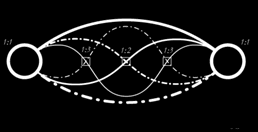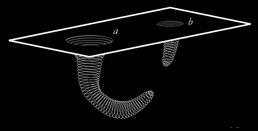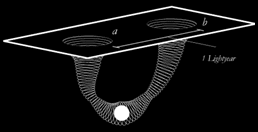目次
星間旅行
転載元:EVEonlineJP Wiki
原文:Scientific Articles:Interstellar Traveling
Copyright © CCP 1997-2017
原文はCCPに著作権があります
アラン・E・トーファー著
ここで、あなたがたの技術的な洗練のため、広大な宇宙を何分かそこらで縦横可能にする驚くべきジャンプ技術に関する詳しい説明を用意した。種族の祖先に関するとらえどころのない探求の歴史に関するさまざまな興味深い話もおりまぜた。EVE世界において最も認められた知識人によって書かれており、この世界に生きる者の知性と信仰への洞察力に富んだ瞥見である。
Well, here is a detailed description for all you techno-buffs on jumps - the amazing technology on how and why it is possible to traverse the vastness of space in a matter of minutes. Tacked along are various interesting tidbits on the history of the races and their elusive search for their ancestry. Written by one of the best recognized intellectual in the world of EVE, this is an insightful glimpse into the minds and beliefs of those that live there.
1 我々はどこからきたのか?
幾世紀も人々は、人類がどこから来たのか思索してきた。今日では合理的疑の余地なく、我々の銀河で見つかったすべての種族と派閥は共通の源に起源をもつはずであるということが立証されている。
For centuries men speculated from where mankind came. Today, it has been established beyond reasonable doubt that all the different races and factions found in our part of the galaxy must have originated from a common source.
しかし、あらゆる人工物の断片をつなぎ合わせ首尾一貫した全体像にするのは難しいことがわかっている。とにかく、生物学的見地から人類が同一の惑星で進化したことは合理的であるようだ。たとえ多様な相違点が派閥間、派閥内にあったとしても、DNA構造の類似が明確に共通起源を示唆している。しかしだとしたら、ここで疑問がうまれる。どこにこの人類が進化をとげた伝説的惑星があり、どのように人類は幾多の離れた場所にたどりついたのか。

Yet it has proven difficult to piece all the different artifacts together into a coherent picture. In any case, it seems logical from a biological standpoint that humans evolved on the same planet. Even if various differences can be found between and within factions, the likeness in the DNA structure clearly points to a common origin. But then the question is: where is this fabled planet that humans evolved on and how did the human race end up in numerous separate places?
我々の知っていることをみてみよう。今、恒星間航行が可能な種族が我々の宇宙を何千年か昔彷徨していたのは疑いの余地がない。多くの古代ジャンプゲートやその欠片が多くの星系に存在することが知られている。これらジャンプゲートが我々の祖先によって作られたものか、エイリアンによるものかは未知である。これらジャンプゲートはいくつかの奇妙な特徴がある。始めに、年代測定によるとすべてのこれらジャンプゲートは50年間から100年間の間に構築されたものであった。そして多くのジャンプゲートのデザインは場所によって少し違い、まるで別の人々によって構築されたかのようである。これらの事実から多くの疑問が生れる。なぜ、すべてが短い期間に構築されたか、そしてなぜそれ以来とだえたか。それらは同一種族により作られたのか、それとももしかしたら2つかそれ以上の対立する種族によってだろうか。
Lets look at what we know: It is now undoubted that a race capable of inter-stellar travel roamed our space many thousands of years ago. A number of ancient jump gates, or fractions of jump gates, are known to exist in numerous solar systems. Whether these jump gates were built by our own ancestors or a totally alien race is unknown. These jump gates have some peculiar traits. First of all, age tests have shown that all these jump gates were built within the space of 50 to 100 years. And yet the design of many of the jump gates is a little bit varied between places, like they were constructed by different people. These facts raise many questions: why were they all constructed within this short time-span, and none since? Were they built by the same race, or maybe two or more conflicting races?
最も有力な説は、戦争である。紛争のみがこの多くのジャンプゲートの迅速な構築と、すべてがある日突然停止したようにみえることを説明づけることができる。だが一体誰が戦っていたのか。そして交戦国は今はどこに?恒星間戦争が可能な派閥が突然姿を消すとはとてもありそうに思えない。
The answer most favored is that of war. Only a conflict could explain this quick construction of dozens of jump gates and why everything seemed to come to an abrupt halt one day. But who were fighting? And where are the combatants now? It seems highly unlikely that factions capable of inter-stellar warfare suddenly disappear into thin air.
ジャンプゲートの残余の配置を研究することによって、奇妙なパターンが現れた。ジャンプゲートは中心点から蜘蛛の巣のようにくねっているのである。中心点とは何か?それは最初にそれを発見したアマー人に知られた星系で、'イムラオ・エーマン'とか'神の口'と呼ばれるが、今日ではEVEとしてよく知られている。
By studying the layout of the jump gate remnants, a curious pattern emerges. The jump gates snake out like a spider-web from a central point. And what is the central point? It is the system known to Amarrians, who first found it, as ‘Imlau Eman’, or the ‘Mouth of God’, but is today better known as EVE.
EVE星系は不可解でいまだ我々にとって謎だ。星系自体はそれほど印象的ではない。単にいくつかの宇宙塵と少し小惑星帯が青白い白色矮星を周回している。 しかし星系のはずれに何世紀もの間我々を当惑させている事象がある。この事象の中心には明らかになんらかの高度な文明によってはるか昔に建設された巨大な構造物がある。構造物はジャンプゲートに非常によく似ているが、我々のどんな宇宙構造物の何倍も大きい。ゲートは全体的に平らだが、そこかしこにまだ完全には解読されていない古来の言語による印がある。これらのうち最も大きな印が上端に、3字の語でEVEとある。この語の意味については学者間で十分には一致がなされないが、ほとんどの人は単にゲートの名前であると見ている。
The EVE system is an enigma that is still very much a mystery to us. The system itself is not that impressive – just some space debris and a few asteroid belts orbiting a pale white dwarf. But at the outskirts of the system is a phenomenon that has puzzled us for centuries. At the center of this phenomenon lies a huge structure, obviously built by some advanced civilization eons ago. The structure looks very much like a jump gate, except it is many times bigger than any space structure of ours. The gate is fairly plain all around, but there are markings here and there, in some ancient language that has not been fully decrypted. At the top, the largest of these markings is a three-letter word that says EVE. There isn’t full agreement among scholars about the meaning of this word, but most people regard it to be simply the name of the gate.
今、すべての状況が、これが我々の祖先がこの世界に入るために使われたゲートであることを示唆しているが、このゲートとEVE星系全体に関する大規模な研究をよそに、いまだこのゲートに何千年か前何がおこったか明らかになっていない。
Now, every indication points to this being the gate that our forefathers used to enter this world, but despite massive studies on the gate and the EVE system in whole, we still haven’t uncovered what happened to the gate all these millenniums ago.
一般的にいわれるのは、極度にまぶしい強力な電磁乱気流がEVEゲートから発せられているという。この乱気流はゲートの中からきていると見られていて、ゲートは実際に開いていて、電磁嵐はゲートが接続されている先からきているのだと信じられている。
Extremely bright and powerful electromagnetic turbulence emits from the EVE gate, as it is commonly called. This turbulence seems to originate from within the gate, so it is believed that the gate is actually open and the electromagnetic storms are coming through from wherever the gate is linked to.
ともかく、この乱気流がゲートの研究を非常に困難にしている。幸運なことに嵐は周期的に振動していて、1年かそれぐらいおきにより近くでの観察が可能になるほど弱まる。しかしそれでも乱気流は愚かにも近くまで彷徨するどんな船も引き裂いて断片にするほどである。
In any case, the turbulence makes it extremely difficult to study the gate. Fortunately, the storms pulsate rhythmically, meaning that every other year or so they recede enough to allow closer scrutinizing. But even then the turbulence is enough to rip to pieces any vessel foolish enough to wander close to it.
ゲートから発せられるとほうもない明るさは、EVE星系に近い星系から夜空に揺れる輝く星として、簡単に見ることができる。また、既知世界の最も遠い領域の星系においても、望遠鏡の助けを借りて見ることができる。アマー人の母星系はEVE星系からたった数光年であり、驚異のゲートへの最適な場所である。幾年も昔、まだ原始レベルの時、アマー人は実際、空に見える奇妙な現象と古くからの信仰とを結びつけて考え、今日にいたってもEVEゲートはアマー人国教において非常に重要である。
The immense brightness emitting from the gate can easily be seen in solar systems close to the EVE system as a vibrating bright star on the night sky. But even in systems in the farthest regions of the known world it can still be seen with the aid of a telescope. The Amarrians, whose home system is only a few light-years from the EVE system, were in the best position to marvel at the gate. Many thousands of years ago, while still on a primitive level, the Amarrians actually coupled the peculiar phenomenon they saw in the sky with their age-old religion and even today the EVE gate holds great importance in the Amarrian state religion.
我々の祖先への探求は進み続ける。たとえ事実が我々をEVE星系に導いたとしても、それは道の終端であるようにおもえる。何十年にもわたる広域の研究は、この重大な問いの答えにまったく近づいていないようである。
The search for our ancestors goes on. Even if the facts lead us to the EVE system, it seems to be the end of the road. The extensive studies done there over the decades seem no closer to providing the answer to this important question.
2 最古のジャンプゲートと初の星間航行
一度アマー帝国が宇宙に進出できるほどの技術レベルに達すると、活発に母星系の地図が作られはじめた。技術的制限によりこの探索には長い時間がかかった。ついに、アマー人は母星系の外れにてジャンプゲートの遺跡に遭遇した。
Once the Amarr Empire had reached the technology level were it could enter space, it started to vigorously chart their home system. Due to technological limitations this survey took a long time. Finally, the Amarrians stumbled upon the remains of a jump gate at the outskirts of their solar system.
遺跡の研究により、遺跡がほぼ無傷であったこともあり、アマー人は自らのジャンプゲートを構築するのに十分な情報を集めることができた。遺跡のジャンプゲートは利用可能であったが、そのようなものは他になかったので明らかに接続先の他のジャンプゲートを欠いていた。なのでアマー人は安定的にワームホールを星系に形成可能になる前に、2つのゲートを繋ぐために物理的にジャンプゲートを建設可能な船を送らねばならなかった。これらのゲート構築船はしばしば到達に何十年もかかるので、乗員は航海の間冷凍タンクに凍結された。近年になってやっとジャンプゲートなしに星系間をジャンプすることのできるジャンプドライブが生まれ、このジャンプゲートをつかった恒星間航行の前の多大な時間を必要とする準備を打開することができたが、今日でもかなり多くのゲート構築船が遠い星系へと配送中である。
By studying the remains, which were more or less intact, the Amarrians were able to garner enough information to build a jump gate of their own. The jump gate was operational but obviously it lacked connections to other jump gates, as it was the only one of its kind. Thus the Amarrians were forced to physically send ships capable of building jump gates between solar systems before a stable wormhole could be formed into the system to connect the two gates. These gate construction ships often took decades to arrive, the crew suspended in cryo-tanks for the duration of the voyage. Only in recent years with the coming of jump drives capable of jumping between systems with no jump gates in them is it possible to overcome this time-consuming prelude to inter-stellar traveling via jump gates and still today dozens of gate construction ships are enroute to a distant system.
しかし、忍耐は美徳であることをアマー人は非常によく心得ていたので彼等はアマーの母星系からすべての方向に着実に拡大させていった。最初のジャンプゲート構築から2千年以上たった現在、アマー人は何百もの星系を占領している。
But patience is a virtue the Amarrians have mastered well and they steadily expanded in every direction from their Amarr home system. Now, more than two millenniums since the construction of their first jump gate, the Amarrians occupy hundreds of solar systems.
ガレンテ人とカルダリ人は単純に彼らの母星が同じ星系にあったため、ジャンプゲート技術を比較的に同時期に発見した。これは700年強前のことである。ガレンテ人とカルダリ人は、彼等の星系においてアマー人のように比較的無傷のジャンプゲート遺跡を発見するという幸運には恵まれなかった。そのかわりに断片的な破片しか発見されなかったため、足場にするものがなにもなかった。それでも、これら断片が研究者を正しい方向に導き、多くのジャンプゲート理論が試された。母星系の、連星系としてのもう一方の茶色矮性が発見され、ゲート研究は正しい軌道にのった。それからは初のジャンプゲート構築までそれほど時間がかからなかった。アマー形式のジャンプゲートも、ガレンテ/カルダリ形式も、どのようにゲートの別々の部分が正確に動いているかという小さな相違点はあるものの、共に共通の原理(次章を参考)で動いている。

The Gallenteans and the Caldari discovered jump gate technology at relatively the same time, due to the simple fact that their home worlds were then in the same system. This was a little over 700 years ago. The Gallenteans and the Caldari did not enjoy the luxury of finding a relatively intact jump gate relic in their system as the Amarrians did. Instead there were only fragmentary pieces to be found, so they had nothing to build on. Still, these fragments pointed the researchers into the right direction and many jump gate theories were tried out. It wasn’t until after the discovery of a companion brown dwarf, making the system a binary system, that the gate research got on the right track. It wasn’t long after that before the first working jump gate was erected. The Amarr type of jump gate and the Gallente/Caldari one both work on the same principle (see next chapter), but there are some minuscule differences in how the different parts of the gate work exactly.
ガレンテとカルダリの世界がはちきれそうなほど膨れあがるころ、ジャンプゲート建設のため船を近隣の星系に送るという大くの努力がなされた。ガレンテ人とカルダリ人の他星系への大量の移住は、アマー帝国が同時には1つの星系のみに植民し、進出のすべての面において国が厳格に制御したようには穏やかに進まなかった。かわりに、個人企業である最初のカルダリ企業が主として星系の調査の責任を担い、建築船を送り、入植者に領土を売った。約500年の間に、ガレンテとカルダリ、2つをあわせた発展は、アマー人が2000年かけて行なった全発展とほぼ同じほどになった。
At that time both the Gallente and the Caldari worlds were bursting at the seams and major effort was made in sending ships to nearby systems to build jump gates. The mass exodus of the Gallenteans and the Caldari to other systems was nothing like the calm, deliberate expansion of the Amarr Empire, where only one system was colonized at a time and every aspect of the expansion was rigidly controlled by the state. Instead, private firms, the first of the Caldari Corporations among them, were chiefly responsible for surveying systems, sending the constructions ships, and selling the territory to the colonists. In the space of 500 years or so the combined expansion of the Gallenteans and the Caldari had almost equaled the total expansion of the Amarrians in 2000 years.

この件に関してのジョヴ人の技術的発展については知られていない。今日では彼らもジャンプゲートの機能を同じ原理によって使用しているが、いつどこでジョヴ人がジャンプゲート技術を手に入れたかについて何も知られていない。しかし、興味深い事実が明らかになっている。ジョヴ人の古き伝説によると、ジョヴ人はジャンプゲートが崩壊する前のはるか昔、世界中に散っている古来のジャンプゲートを使い、星系間をジャンプしていたという。伝説ではゲートの製作者については述べられていない。
The Jovians are not very forthcoming with information about their technological advances in this regard. Today they employ jump gates functioning on the same principle as the other’s, but nothing is known on where or when the Jovians acquired their jump gate technology. However, they’ve revealed an interesting fact: according to ancient Jovian legends, the Jovians used the ancient jump gates that scatter the world to travel between solar systems a long time ago, before the jump gates crumbled. The legends stay silent about the makers of the gates.
3 ジャンプゲート技術の原理
ジャンプゲートは連星系における重力共鳴を利用して作られた人工ワームホールを中心に作られる。この共鳴は天体の重力波の干渉なので、天体が大きければより干渉は大きくなる。星系内の惑星の位置や、重惑星の環の複雑な構造も多少この干渉に影響する。

Jump gates are built around artificial wormholes, created by exploiting gravitational resonances found in binary systems. This resonance is as a friction between gravitational waves of stellar objects, the more massive the objects, the stronger the resonance between them. Positions of planets in a solar system, as well as the complex structure of dust rings around heavy planets illustrate this resonance.
連星系には巨大な干渉現象が存在し、そこでは2つの星の安定した双対構造をもった重力場が、2つの源からの波の波紋のように互いに干渉しあう。この安定した波形には連続した定常波が存在し、ギターの弦で作られるのと似ている。最も強い定常波は 1:1 干渉 (つまり、第一高調波)で、2番目に強いのは 1:2 干渉 (第二高調波)で、ここでは追加の固定節点が領域のちょうど2つの星の(もし質量が同じなら)中央に現れる。このようにこの後の他の干渉もなっている。
In binary systems there exists strong resonance phenomenons, where the gravitational field of two stars in a stable binary formation would interfere with each other, like ripples from two wave sources. These stable wave patterns come in a succession of standing wave patterns, similar to those created on a guitar string. The strongest resonance is the 1:1 resonance (the first harmonic, so to speak), with two stationary node points situated in the center of each of the two stars. The second strongest resonance is the 1:2 resonance (the second harmonic), where an additional stationary node point appears in the field exactly mid-way between the stars (if of equal mass), and so on for successive resonances.
接点では反対の方向からくる重力場の高周波の振動がエネルギー-運動量テンソルに強いせん断を形成する。普通の状況ではこの応力は高周波の重力子放射により消散してしまい、マクロな現象を作りだすことはない。
At the node points, the rapid oscillation of the gravitational field in opposite directions creates strong shear in the contravariant energy-momentum tensor. Under normal circumstances this stress is dissipated by high-frequency graviton radiation, and does thus not create any noticeable macroscopic phenomenons.
しかしこの応力が閉じこめられ、限られた空間領域にのみへの集積を強制されると、テンソル場は最終的には徐々に成長する四次元空間連続体内の構造のような高曲率の触手を発展させるに至る。より具体的には、触手は自己からより遠ざかろうとする自己回避4次元多様体を形成する。触手の先端では曲率が最大になり、時空間上で磁石のように実質的に振舞い、十分に高い曲率で最終的には離れた高密度領域に小さな触手を形成させるに至り、これが先端に届き自然と一体化しうる。この現象に似た現象として例えば、雷が地面に落ちるとき、下向きの雷の先端が実は地面から発せられる小さな上向きの雷を形成し、2つが地面より上のどこかで一体化し、閉じた電気回路を形成する。
But if this stress is confined and forced to build-up in a limited region of space, then the tensor-field will eventually develop a steadily growing high-curvature tentacle like structure in the space-time continuum. More specifically, the tentacle constitutes a self-avoiding 4-manifold that attempts to grow farther and farther from itself. The tip of the tentacle, where the curvature is highest, effectively acts like a magnet on space-time, and for high enough curvature it can eventually induce the creation of a small tentacle in remote high-density regions, that can reach to the tip and spontaneously combine. An analogy of this phenomenon is when lightning strikes ground, where the tip of the downward lightning actually creates a small upward lightning emanating from the ground and the two combine somewhere above the ground, thus closing the electrical circuit.

ジャンプゲートの主装置は、質量ボソン球と呼ばれ、質量を媒介とし、重力波と強く相互干渉する基礎物理場の一つに基づいている。この球は、鏡が光を反射するごとく、重力波を反射する質量ボソンプラズマで見たされている。プラズマの密度を調節し、テンソルせん断の損失に関与する高周波重力波を反射するようにすることで、この放射は球内に閉じこめられ、共鳴節点の重力応力の安定した純増加をもたらし、最終的には高曲率触手の形成に至る。これに似た例として、レーザーは、発振器を反射空洞に閉じこめることにより、電磁エネルギーが増幅され、完全に位相が揃ったコヒーレンス光を一部取り出すことにより作られる。
The main device of jump gates is a so-called mass boson sphere, based on one of the fundamental physic fields that mediates mass, and thus interacts strongly with gravitational waves. The sphere is filled with mass boson plasma, which reflects gravitational waves, pretty much in the same way as a mirror reflects light. By adjusting the plasma density so that it reflects the high-frequency gravitational waves involved in the dissipation of tensor shear, this radiation is trapped within the sphere, thus leading to a steady net increase of the gravitational stress within the resonance node, which eventually leads to the creation of the high-curvature tentacle. An analogy of this is the laser, which builds up a highly coherent and intense beam of electromagnetic energy by enclosing oscillators within a reflecting cavity.
ワームホールの2端の距離は連星系の2つの太陽の質量と、ジャンプゲートがどの共鳴節点に位置しているかに依存する。2つのジャンプゲートを接続するには、試行錯誤的手法が必要で、しばしば何年も要する。これはテンソル場により作られる触手をどこで開くか制御したり導いたりできないからである。しかし、触手が成長するのと同時に、近隣の星系にあるジャンプゲートで臨界点を越えさせずに重力応力を形成させることで、まだ多くの試行が必要ではあるが、接続の可能性は統計的には増える。これは雷を伴う暴雨の時、金属棒を上げるのと似ている。
The distance between the two ends of the wormhole depends on the mass of the suns in the binary system and on what resonance node the jump gate is located. In order to connect two jump gates a trial-and-error method is needed, often lasting many years. This is because the tentacle created by the tensor-field cannot be controlled or directed in where to open. But by having another jump gate in a nearby system build up gravitational-stress in it its own, without reaching critical point, at the same time that the tentacle is growing, then the likelihood of a connection being made increases statistically, although many attempts are still often needed. This is similar to raising a metal rod in a thunder storm.
アマー人により最初に作られた種類のジャンプゲートは、一度ワームホールを形成し船が通過すると、他の船が通る前に新しいワームホールを形成しなくてはいけないという制限があった。2つのジャンプゲートが再接続されるには何日か、あるいは何ヶ月かかかったので、通過には時間がかかった。後のジャンプゲートではより長い間ワームホールを保持できるようになり、今日ではジャンプゲートはワームホール接続を幾十年もリセットせずに保持することができる。さらに初期のジャンプゲートは同時には一つのワームホールしか接続、保持できなかったが、今日ではいくつかのワームホールを同時に開けるので、同時に複数の他のジャンプゲートと接続することができる。
The first jump gate versions built by the Amarrians were limited in the way that once a wormhole had been created and a ship slipped through a new wormhole had to be made before another ships could pass. As it could take several days or even months to re-connect the two jump gates, passing was slow. Later versions of jump gates allowed the jump gates to hold the wormhole open for a longer time and modern day jump gates can keep a wormhole connection open for several dozen years before it has to be reset. Also, the first jump gates were only able to connect and hold a single wormhole at a time but today they can hold several wormholes open at the same time, allowing jump gates to be connected to several other jump gates at once.
標準的な連星系では、ジャンプゲートが第三共鳴節点に構築されたとすると、ジャンプゲートは約5光年の範囲になる。連星間の第二共鳴節点に構築すればより強力なジャンプゲートとなる。これらの節点は星系からかなり遠く(通常0.5光年ほどまで)、もっと重要なことにはより利用するのが難しかったので、利用されはじめたのはつい最近になってからである。他方、これらは通常のジャンプゲートよりずっと大きな範囲を持つ。
In an average binary system the jump gate has a range of around 5 light-years, provided the jump gate is constructed on the third resonance node. More powerful jump gates can be constructed on the second resonance node between the stars. Because these nodes are much farther from a solar system (often up to 0.5 lightyear away) and, more importantly, are also harder to harness, they have only recently started to be utilized. On the other hand, they have much greater range than the basic jump gates.
ジャンプゲート航行にはいくつかの厳しい制限がある。まず始めに、共鳴節点のため、ジャンプゲートは2つかそれ以上の恒星をもつ星系にのみ構築可能である。ここで事実上3つに1つの星系がジャンプゲート構築に不適合となる。
There are several strict limitations on jump gate travel. First of all, jump gates can only be constructed in systems with two or more suns, because of the resonance nodes. This effectively makes one in every three systems ineligible for jump gate construction.
次に、ある星系においてある時点では1つのジャンプゲートのみが動作可能である。これは質量ボソン球による共鳴場における不安定な変動に起因するものである。もし1つ以上のボソン球が同時に同星系で活性化すると両方とも非常に不安定になり、動作不能になる。

Secondly, only one jump gate can be in operation in a system at any given time. This is due to the erratic fluctuations in the resonance fields caused by a mass boson sphere; if more than one such sphere is active at the same time in the same system, they both become highly unstable and impossible to operate.
そして3つめとして、ワームホールの両端がジャンプゲートに接続されている時のみ、船はそれを通過して航行可能である。これはつまり、ジャンプゲート構築のためには船は、星系間の通常空間を航行しなければならないということである。この原因は触手の縦方向の次元にそった空間の極度な拡張、つまりワームホールの長さ方向の空間座標が拡張する一方で、動径成分は循環的に湾曲しているからである。ワームホールに入った宇宙船はその強い空間勾配に支配され、構造的完全性が危険にさらされる。これは船周辺の伸縮を局所的に対抗することで回避できる。ここで、質量ボソン球はゲートの仕組みにおいて2番目の役割を果す。船が質量ボソン球を通過する際、質量ボソンの単原子層が船表面に溶着する。この層が空間勾配に対する船の伸縮に対抗し、ワームホールを通過する間の船の構造的完全性を保つ。これは勾配が完全に消えることを意味するわけでなく、熟練の宇宙パイロットでもワームホールに入る時には'配水管に落ちる'という感覚を忘れない。
And thirdly, ships can only travel through wormholes if both ends of it are connected to a jump gate. This means that ships must travel between systems in normal space in order to build a jump gate. The reason for this is the extreme dilatation of the metric along the longitudinal dimension of the tentacle, meaning that the spatial coordinate along the length of the wormhole is expanded, while the radial component is cyclically curved. A spaceship entering the wormhole is subject to a strong metric gradient that would put its structural integrity in jeopardy. This can be prevented by locally countering the stretching around the immediate vicinity of the ship. Here the mass boson sphere plays its second role in the gate mechanism. When the ship goes through the mass boson sphere, a mono-atomic layer of mass boson gets deposited on the ships surface. This layer counters the stretching of the ship against the metric gradient, enough to keep the structural integrity of the ship for the duration of the trip through the hole. This doesn't mean that the gradient is completely wiped out, and even seasoned space veterans still know the feeling known as 'going down the drain' when entering a wormhole.
4 宇宙船の加速 : 最初のジャンプドライブ
(編注:これ以降で言及される「ジャンプドライブ」とは、ゲーム内でいうところの「ワープドライブ」のことを指します。)
高度な推進システムをもってしても、星系内の惑星間を移動するには数日か数週間もかかる。この航行を速める方法はそれゆえ、すべての人間にとっての重要な関心事であった。
Even with advanced propulsion systems it took space ships days or weeks to move between planets in a solar system. Anything that could quicken this travel was thus of immense interest for everybody.
船の速度を向上するためさまざまな取り組みがおこなわれたが、そのほとんどは大きすぎる燃料容量とコストか、適用範囲が限られすぎているかで、失敗におわった。最も成功した試みはミンマター帝国のもので、重力を独自の方法で使用した加速ゲートを構築し、惑星間で船をパチンコで飛ばすものだった。これによって船は惑星間を依然よりずっと短い時間で飛ぶために十分な運動量を得ることができた。しかしミンマターは恒星間ジャンプゲートを構築する方法を発見することはなかったので、この加速ゲートはミンマターの母星系のみに限られた。(現在でも存在している。) 彼らは恒星間を航行できるより大きな加速ゲートの実験を始めていたが、アマー人の侵攻を受け奴隷にされるより前にそれを建設する出番はなかった。
Various efforts were made to increase the speed of ships, but most of them failed either because of too high fuel volume and cost, or because they were too limited in scope. The most successful attempt was that of the old Minmatar Empire, which built acceleration gates that employed gravity in an unique way to slingshot ships between planets. This gave the ships enough momentum to fly between planets in a much shorter time than before. But the Minmatars never discovered how to build inter-stellar jump gates, so their acceleration gates were limited to their home system (where they still exist today). They had begun experimenting with much larger acceleration gates capable of sending ships between solar systems, but they never got a chance to build them before the Amarrians invaded and enslaved the Minmatars.
アマー帝国自身は、成長し続ける宇宙帝国であったにもかかわらず、この点に関しての躍進することに対しては悠長であった。長い間、光速の約10%での航行で何とか済ませていて、彼らにはこの速度で十分に思えた。とうとう、彼らはジャンプドライブ技術の根底にある原理を新兵器技術研究の過程で偶然発見した。アマー人の最初のジャンプドライブは約300年前に作られた。

The Amarr Empire itself was slow to make any breakthroughs in this regard, despite their ever-growing space empire. For a long time they made do with ships traveling at ca. 10% of the speed of light, this speed seemed sufficient to them. At last they discovered the principles behind jump drive technology more or less accidentally, while researching new weapon technologies. The first Amarrian jump drive was built nearly 300 years ago.
ガレンテとカルダリでは状況が違った。彼らの母惑星群は同星系に存在し、これはつまり、星系内通商が彼らの社会において、宇宙活動に着手した時からすぐに重要な要素になったということである。故に、星系内航行に対する満足のいく解決策を発見するかなり重要な動機があったのである。最初に建設されたジャンプドライブはカルダリの技術者により600年以上前に建設されたソティヨ-ウルバータドライブである。これは非常に巨大で、途方もなく高価で、ものすごく非効率であったが、うまく動いた。ソティヨ-ウルバータドライブは後のバージョンになるにつれ、ガレンテ人とカルダリ人双方の社会的、技術的発展を大幅に加速し、疑われることなく、最も重要な発明の一つとなった。
The situation was different for the Gallenteans and Caldari. Their home planets were in the same system and this meant that intra-system trade runs became an important element in their society right from the outset of their space activity. Thus there was a much greater incentive to find an acceptable solution to intra-system travel. The first jump drive built is the Sotiyo-Urbaata Drive, built by Caldari engineers more than 600 years ago. It was immensely big, tremendously expensive and outrageously inefficient, but it worked. The Sotiyo-Urbaata Drive, along with later versions, sped considerably up the social and technological development for both the Gallenteans and the Caldari and is without a doubt one of the most important discoveries ever made.
何世紀も前の昔始めてジャンプドライブが登場してから、ジャンプドライブは一層発展し、より安価に確実に、効率的になった。今のところソティヨ-ウルバータドライブと今日のドライブにはそう大差はない。両方とも同じ基本原理の上で動き、星系内の高速航行を可能にする。しかし最新のジャンプドライブは、たとえジャンプゲートがない場所においても星系を縦走できるので、真のジャンプドライブである。この革命的ジャンプドライブは、いまだ比較的貴重で高価であるが、ジャンプゲート技術と旧来のジャンプドライブ技術を組み合わせて全く新しい装置の一部を作り出した。
Since their first appearance all these long centuries ago, jump drives have become ever more advanced, making them cheaper, more reliable and more efficient. Yet the difference between the Sotiyo-Urbaata Drive and a modern day drive is not so great; both work on the same underlying principle, both allow very fast travel within the solar system. But the latest versions of jump drives are for many the true jump drives, for they allow ships to traverse solar systems even where there are no jump gates. These revolutionary jump drives, which are still relatively rare and expensive, combine traditional jump drive technology with jump gate technology and create a whole new piece of equipment.
5 超光速航行、どのように?
では、超光速航行ができるわけとは?これは、量子電磁気学の分野における先端研究を通して発見された。劣化真空、これは全エネルギーが完全に除去された宇宙空間にある真空のことだが、これを生成し、拡張し船を包むようにすることで、宇宙船はこの劣化真空の泡を通して超光速移動が可能になる。劣化真空泡は摩擦がないだけでなく減摩性を持ち、物質(光を含む)はその中においては完全な真空の中よりも実質的に速く移動することができる。
So what is the elusive answer to FTL travel? It was found through advanced research in the field of quantum electrodynamics. By creating depleted vacuum, that is, vacuum as found in space but completely stripped of all energy, and then expanding this depleted vacuum to envelop a ship, the ship is capable of moving faster than light through this bubble of depleted vacuum. A depleted vacuum bubble is more than frictionless – it is so anti-friction that things (including light) actually move faster in it than they would in complete vacuum.
全宇宙船はジャンプドライブ装置を装備している。このジャンプドライブが2枚の双極円盤の間で繰り返し真空を'圧縮'し、中から外へ全エネルギー中性子とクオークを排出することで劣化真空を生成する。そして、増加しつづける劣化真空泡をそれが船全体を包みおわるまで拘束するためレーザー固定された場が形成される。船が包みこまれると超光速に入ることができる。ジャンプドライブの初期実験は技術的に非常に有望であったが、航法に関して問題が発生した。一度宇宙船が超光速に到達すると、通信や走査(スキャン)の目的などで、世界と干渉することが難しくなる。例えばコンパクト次元無線などのさまざまな実験がなされたが成功しなかった。量子力学の予測不可能な性質により、変動する速度から正確な時間計測ができるほど十分安定した真空泡を作り出すのが難しくなっている。最終的には解決策が見つかった。ジャンプゲートに使われる制御システムに似た重力キャパシタが、宇宙船が超光速の間、通常空間から重力信号を取得することができたことが発見された。キャパシタをそれらの信号の一つに固定して、そこへ航行する。ここで、一度重力井戸からのある一定の距離が得られると、泡は自動的に分散される。唯一の問題は、このキャパシタはある大きさ以上の重力井戸からの信号のみ効率的に取得できることで、最小のものは小さな月か小惑星群である。また、重力キャパシタが恒星の位置と比較し正確に目標対象へ調節するためには、目標までへの比較的狭い経路に重力井戸がないといけないので、結果的に船の航行できる領域はかなり制限される。これはジャンプドライブの使用法にいくらか制限を課すが、その星系のすべての大きな物を検出できればこれは大問題にはならない。さらに現在では宇宙ステーションやジャンプゲートに偽の重力井戸を構築することができ、宇宙船のジャンプドライブの一部である重力キャパシタにより検出できるので、それに向って飛ぶことができる。
All space ships are equipped with a jump drive device. The jump drive creates depleted vacuum by repeatedly ‘compressing’ vacuum between two polar discs, draining all energy neutrons and quarks out of it. A laser-locked field is then created to hold the ever-increasing depleted vacuum bubble until it has enveloped the whole ship. When that happens the ship is able to enter FTL speed. Although initial experiments with the jump drive were very encouraging technology wise, problems arose in regard to navigation. Once the ship has attained FTL speed, it is very difficult for it to act or react to the world, such as for communication or scanning purposes. Numerous experiments were made, for example with compactified dimensions radio, but without success. The unpredictable nature of quantum mechanics made it very difficult to create a stable enough vacuum bubbles to allow for precise time measurements due to fluctuating speeds. Finally, a solution was found. It was discovered that gravity capacitors similar to the control system used in jump gates were able to pick up gravity signals from ‘normal’ space while the ship was on FTL speed. By locking the capacitor onto one of these signals, the ship travels to it. The bubble is then automatically dispersed once certain distance from the gravity well is acquired. The only problem is that these capacitors can only efficiently pick up signals from gravity wells of certain size or above, with the minimum being a small moon or a cluster of asteroids. Also, in order for the gravity capacitor to align correctly on the destination object in relevance to the position of the sun, it must follow a relatively narrow route towards it, resulting in a fairly restricted emerge area for the ship. This puts some limits on the jump drive’s usage, but as all major objects in a system can be detected, this is not such a great problem. Furthermore, it is now possible to construct ‘fake’ gravity wells on space stations and jump gates, which can be detected and thus homed onto by the gravity capacitor that is part of a ship’s jump drive.
ジャンプドライブのさらなる研究、特にジャンプドライブ技術とジャンプゲート技術を融合する目的の研究によって、より高度なジャンプドライブが利用可能になった。現在では星系間航行可能なジャンプドライブを宇宙船に取り付けることが可能だ。このジャンプドライブの初期のバージョンでは別の星系にあるジャンプゲートと接続し単にジャンプゲートを通ったかのようにジャンプできた。後のバージョンではジャンプゲートのある星系からジャンプゲートのない別の星系に飛ぶことができた。そして最新のバージョンでは、まだプロトタイプであるが、どちらの星系にもジャンプゲートがなくても飛ぶことができる。初期バージョンは単にドライブを星系の最も近い節点(しばしば1:4かさらには1:5の節点)と協調させ、船が通るのに十分な時間の一時的な小さなワームホールを作る。ジャンプゲートのない星系にジャンプするより上級バージョンのジャンプゲートは少し複雑だ。これは逆相対性理論の平坦な宇宙原理に基づき、絶え間なく高周波の中性子線を一斉照射し、極小宇宙ひもを通じて目標星系を探し出す。この調査は宇宙船が目標星系へのワームホール(もちろん共鳴節点を通じて。) を作るのに十分なデータを集めるために数日かかることもある。
(編注:ここで言及されているジャンプドライブは、ゲーム内のジャンプドライブに近い。)
Further research into jump drives, especially those aimed at amalgamating the technology used for jump drives and the one used for jump gates, has led to more and more advanced jump drives becoming available. It is now possible to fit a ship with a jump drive capable of inter-stellar travel. The first versions of these allowed the jump drive to connect to a jump gate in another solar system and jump to it just as if the ship had moved through a jump gate. The later versions allow ships to jump from a system with a jump gate to another system that has no jump gate, and the latest version, still only available as a prototype, allows a ship to jump between systems even if no jump gate exists in either system. The first versions of these drives simply aligned the drive with the nearest resonance node in the system (often using nodes 1:4 or even 1:5), then created instant mini-wormholes through it for just enough time for the ship to slip through. More advanced versions, allowing jumps into systems with no jump gates, are a bit more complex. They send out a constant barrage of high frequency neutron rays, based on the flat-space principle of trans-relativistic physics, through infinitesimal cosmic strings to scout out the destination system. This survey can last for several days before enough data is gathered to allow the ship to create a wormhole (through a resonance node of course) to the destination system.
6 著者について
アラン・アンブロジウス・トーファーはガレンテ本星のケイル大学において応用物理と実験心理学の学位を取得した。トーファーは才能豊かではあるがしかし型はずれな学生で、卒業後調査会社に入り、20年間離れた星系を彷徨し、天体物理学のデータを集めた。彼が常に異星人の文化に興味をもち、探検に奔走した中心的な理由は異星人の人工物を発見するという願望であった。今日までいまだ数千年前より昔の人工物は何も発見できておらず、数千年程度の物は明らかに人に由来する物である。
Alain Embrosius Topher has a degree in applied physics and experimental psychology from the Caille University on Gallente Prime. Topher, a brilliant but unruly student, signed up with an exploration company after his graduation and spent the next twenty years roaming around remote solar systems, collecting astrophysical data. He has always been enthusiastic about foreign and alien cultures and the main reason for his exploration scurries was the hope to discover alien artifacts. Until now he has not found any artifacts older than a few thousand years old and all which are of obvious human origin.
調査会社にいる間に相当な額を蓄え、トーファーはいよいよ自分の運を試し、数年間をいくつかの有望な星系の調査に費やした。彼一人もしくは2、3人のアシスタントを連れてのこの小旅行は非常に危険でそれゆえ非常に楽しい物だった。トーファーはガレンテ連邦の最も大きなエンターテイメントネットワークの一つと交渉し、この冒険に関するビデオプログラムを作った。これはしばらくの間非常に有名であったが、出目の怪獣とかきらびやかな宝物があるわけでなかったので、公衆はすぐに無関心になった。トーファーはスポットライトの中で注目を浴び終ってから、ビデオプログラムにおいてもっと興奮する(そして金になる)小旅行にするため、この遠出を延期することと決めた。

Having amassed a sizeable sum during his days with the exploration company, Topher finally decided to try his luck on his own and spent the next few years combing several promising systems. Working alone, or at most with a couple of assistants, made these excursions highly dangerous, and thus prime entertainment material. Topher made a deal with one of the largest entertainment network in the Gallente Federation to make vid programs about his adventures. These became hugely popular for a while, but the lack of bug-eyed monsters or glittering treasures soon turned the public indifferent. Topher, who had thrived in the limelight, decided to shelve his excursions for a while in favor of taking more exciting (and lucrative) excursions in vid studios.
トーファーは数年間ビデオスターとしての人生を生きることに満足すると、彼の中の科学者としての彼が注目を浴びたがった。荒れた惑星をもう一度走り回るのには年を取りすぎたように感じて、トーファーはかわりに何らかのゲームのような形態をした教育番組と情報映像を作ることを決めた。やがて彼はまた大成功を収め、何十億ものガレンテ人にとって、彼の名は教育と知識を連想させる誰もが知る名前となった。
Topher was content to live the life of a vid star for some years, but in the end the scientist in him begged for attention. Feeling too old to start running around barren planets again, Topher settled instead on making education shows and info clips, often in the form of games of some sort. Yet again he hit the jackpot and for billions of Gallenteans Topher is a household name associated with education and knowledge.
彼は現在90才前半で、最終的に非常に学術的な生活に落ちついた。彼がビデオプログラムに出ることは稀になり、代わりにほぼ人生で初めて純粋科学へ重点的に取りくんでいる。長年の仲間から、多くの奇妙な考えに基づいた調子のいいインチキと見なされていたが、近年の研究と論文で、同僚から(長いこと延び延びになっていたが)尊敬を集めている。
Now in his early nineties, Topher is finally settling down to a quiet academic life. His vid appearances are now few and far between and instead he’s focusing on pure science, more or less for the first time in his life. Long regarded as a stylish quack with a lot of weird ideas among his fellow scientists, his recent studies and papers has earned him long-overdue respect from many of his peers.
